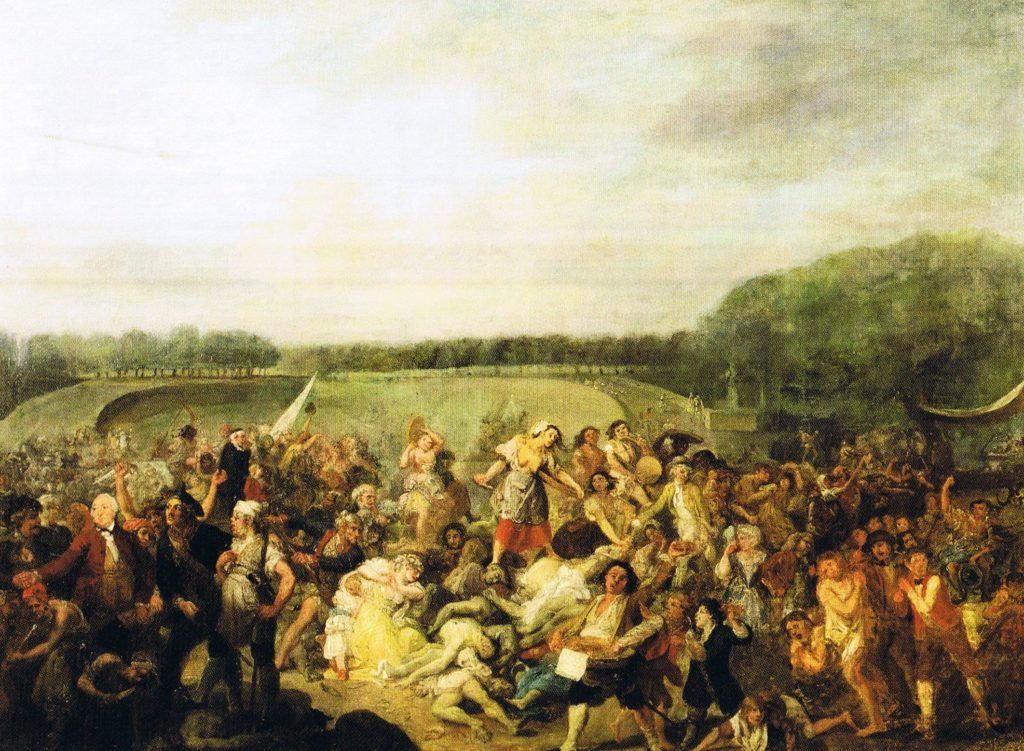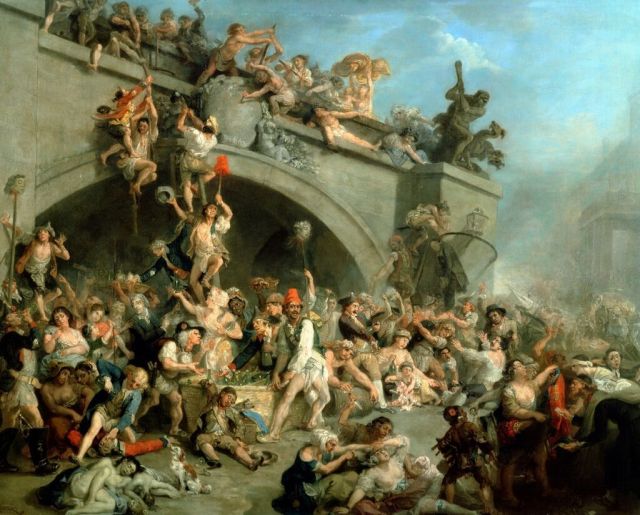‘The Plunder of the King’s Wine Cellar, Paris, 10th August’ Johann Zoffany

I’ve been thinking about an article written recently by our editor here at UnHerd, Tim Montgomerie. In it, he coined a new word: hegemonia.
I’d like to propose one of my own: digitators. They’re the ones who turn the online mob really ugly. They, along with the mob, have a long and inglorious history in real life, but this is their virtual iteration.
What we call ‘mobocracy’ is derived from the Latin ‘mobile vulgus’, meaning the fickle crowd. This was first used in the late 16th century, but after a century or so, it had been shortened to the more familiar English ‘mob’, to describe crowds of people, more menacing than fickle.
By the 18th century, the neologism ‘mobocracy’ began to displace the ancient Greek term for the same thing – rule by the mob. This was ‘ochlocracy’, which along with oligarchy and tyranny, were adversely contrasted with the good forms of government: monarchy, aristocracy and democracy.
Historically, mobs are urban – the Roman emperor Commodus had the head of Cleander cut off and thrown to a ‘mob’ after Cleander deployed his Praetorian Guard to suppress a riot. And they were rarely spontaneous. In the medieval Arab world, men would rush about issuing the ‘fiz’ah’, or ‘panic call’, for ‘urgent mobilisation’ to slaughter Christians or Jews.
But the 18th century was arguably the classic age of the mob. By then, cities had enough people living precariously to constitute a volatile force in its own right, especially in Britain and France, and there were few policemen either.
The 1778 mob uprising was a prime example. The Catholic Relief Act that year repealed harsh 17th-century legislation against ‘Papists’, thereby sparing them from swearing an oath of allegiance to the Church of England, which conveniently opened the way for them to serve in the armed forces at a time when Britain was fighting four powers at once, including the American colonies.
Eponymous riots incited by Lord George Gordon, the head of the Protestant Association, resulted in 40-60,000 people attacking the House of Lords, the Bank of England, and the Clink, Fleet and Newgate prisons as well as the Irish Catholic settlements in Moorfields. In the absence of a police force, the army was deployed, resulting in 285 rioters being shot dead and a similar number of wounded.[1. Christopher Hibbert, King Mob. The Story of the Gordon Riots (London 2004)]
British artists were prominent in depicting the next excesses of furious mobs in action. The Anglo-German artist, Johann Zoffany was clearly influenced by the caricaturists Gilray and Rowlandson when he painted two startling pictures which depicted a real incident during the Jacobin phase of the French Revolution.

The first, at the top of the piece, is The Plunder of the King’s Wine Cellar, Paris, 10th August 1792, the second is Celebrating over the Bodies of the Swiss Soldiers.
Neither leaves much to the imagination: the complete breakdown of order into a drunken and sanguinary bacchanalia is shown in unflinching detail. The presence of black people and women as perpetrators added to the shock of seeing a mob in action, at least in the minds of 18th-century observers.[2. William Pressly, The French Revolution as Blasphemy: Johan Zoffany’s Paintings of the Massacre at Paris, August 10, 1792 (California 1999)]
But what, one may ask, do these raggedy mobs from long ago have to do with us in 2018?
There is good news and bad news. Compared with earlier centuries, instances of large scale rioting seem to have declined, with the exception of when racial tensions act as a catalyst. Even common or garden football hooliganism is nothing like as bad as it was in the 1970s or 80s.
But this is only because the mob mentality has found other ways to express itself. The mob spirit is alive and well on social media, where people routinely express semi-pathological hatreds which they might not do face to face. Anonymity surely helps too.
‘I’m afraid the Nugee creature is fast soaring to the top of my ‘unwatchables’ list, even eclipsing Polly, Shami and The Little Boy Owen. She is the epitome of a wealthy middle class leftie, stuck in a 1970s timewarp of utopian student politics. The audience rightly ridiculed her. What a shame they didn’t have a few bags of rotten tomatoes to chuck…’
This is a comment posted online about the most recent episode of the BBC’s Question Time, which included Shadow Foreign Secretary Emily Thornberry (aka Lady Nugee) as a panelist. This was the polite stuff. More venomous observations can be read 24/7 on the comments sections of newspaper websites, regardless of whether they are broadsheet or tabloid, or tilt Left or Right.
I did say I thought there might be good news. I did wonder if the online message carrier – Twitter in this instance – effectively quarantines these sentiments, so that in the example above, the commentator is not actually throwing his rotten tomatoes at Emily Thornberry, as he might have done in the 18th century. Does the existence of social media mean that atomised ‘slacktivists’ come together in a great electronic hatefest, without there being any wider real world consequences?
Well why not ask that Minnesota dentist and recreational game hunter who killed ‘Cecil’ the Lion, and then found himself menaced by a real-time mob shortly after he was excoriated online.
There is, though, another aspect of mob motivation that is less remarked upon. Throughout history, mobs have relied on intellectual inciters to give righteous focus to their raging emotions. Lord George Gordon – of the riots – was the Eton-educated son of a duke who was a member of parliament, so clearly he was slumming it when he led the mob against Catholics.
Long before the French revolution erupted, the general discourse had been coarsened, by – for example – a wave of pamphlet pornography with the wildest misogynistic aspersions against Marie Antoinette. Many of these libelles against “the Austrian bitch” were produced in London’s Grub Street and smuggled back into France. The Revolution itself empowered a literate underclass of scribblers who, like Jean-Paul Marat, would become the Revolution’s judicial murderers.[4. Robert Darnton, The Forbidden Best-Sellers of Pre-Revolutionary France (London 1996)]
Twitter mobs are not simply a set of sad men (though not exclusively male) venting hateful opinions, but a group that has been prodded, stirred and spurred by a range of facilitators, from social media giants born of newspapers to demi-educated talk radio presenters and TV hosts, who have encouraged the general coarsening and poisoning of our discourse from beneath their masks of TV makeup.
These modern day ‘fi’zahs’ – or digitators – are akin to the bishops, industrialists and field marshals who fawned and bowed to Hitler; they’re an educated ‘rabble’ as the great German-American philosopher Eric Voegelin (1901-85) described them. They bear the greatest responsibility for the mob’s fury nowadays.
Alas, what passes for our high culture has yet to produce anyone remotely comparable to the caustic Viennese satirist Karl Kraus (1874-1936) who described so well what Goethe already gave such elegant form to a century earlier:
Faust: ‘The mob streams up to Satan’s throne, I’d learn things there I’ve never known.
Mephistopheles: ‘The whole mob streams and strives uphill/ One thinks one’s pushing but one’s pushed against one’s will'[5. Eric Voegelin, Collected Works vol. 31 Hitler and the Germans (Colombia, Missouri 1991)]










Join the discussion
Join like minded readers that support our journalism by becoming a paid subscriber
To join the discussion in the comments, become a paid subscriber.
Join like minded readers that support our journalism, read unlimited articles and enjoy other subscriber-only benefits.
Subscribe